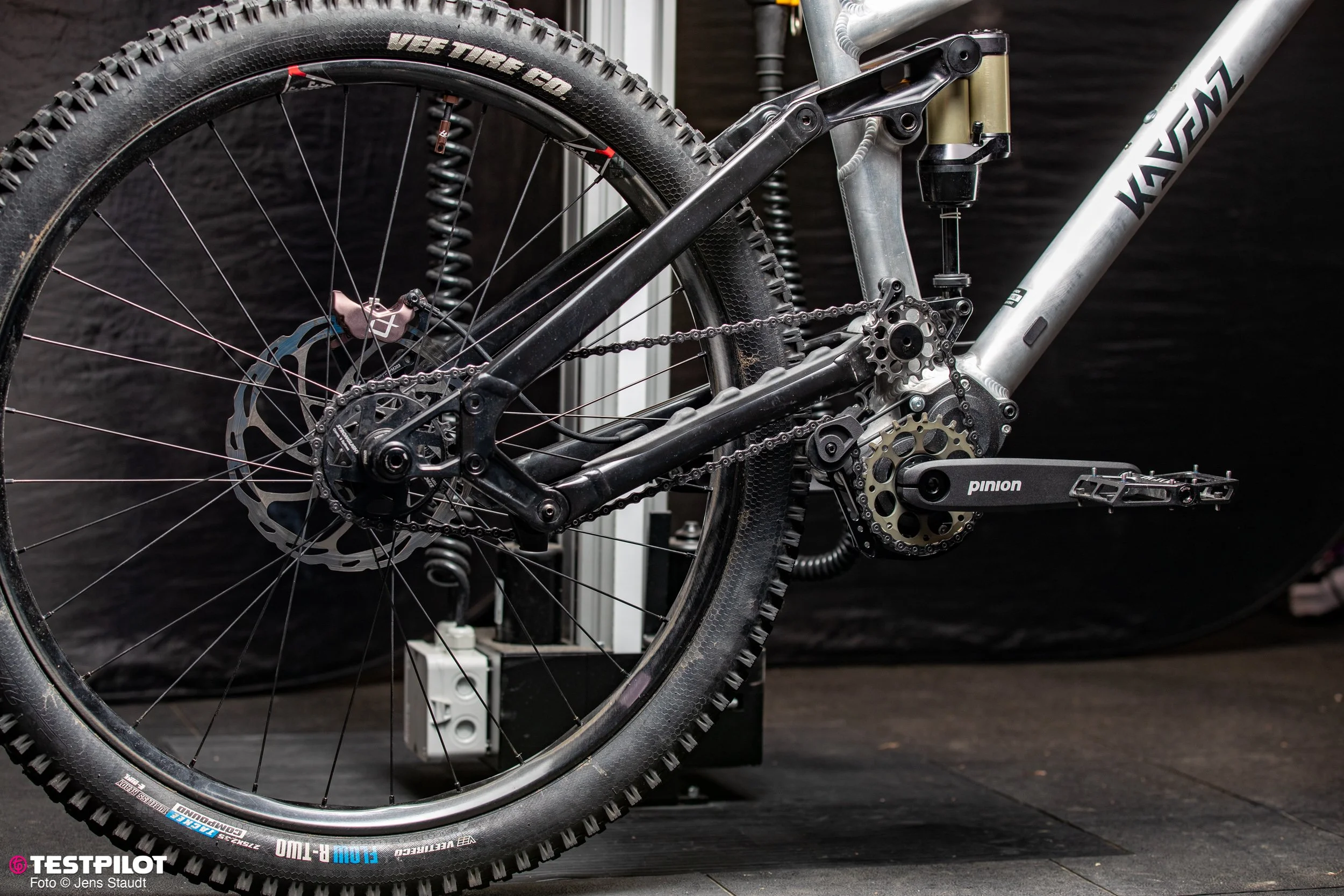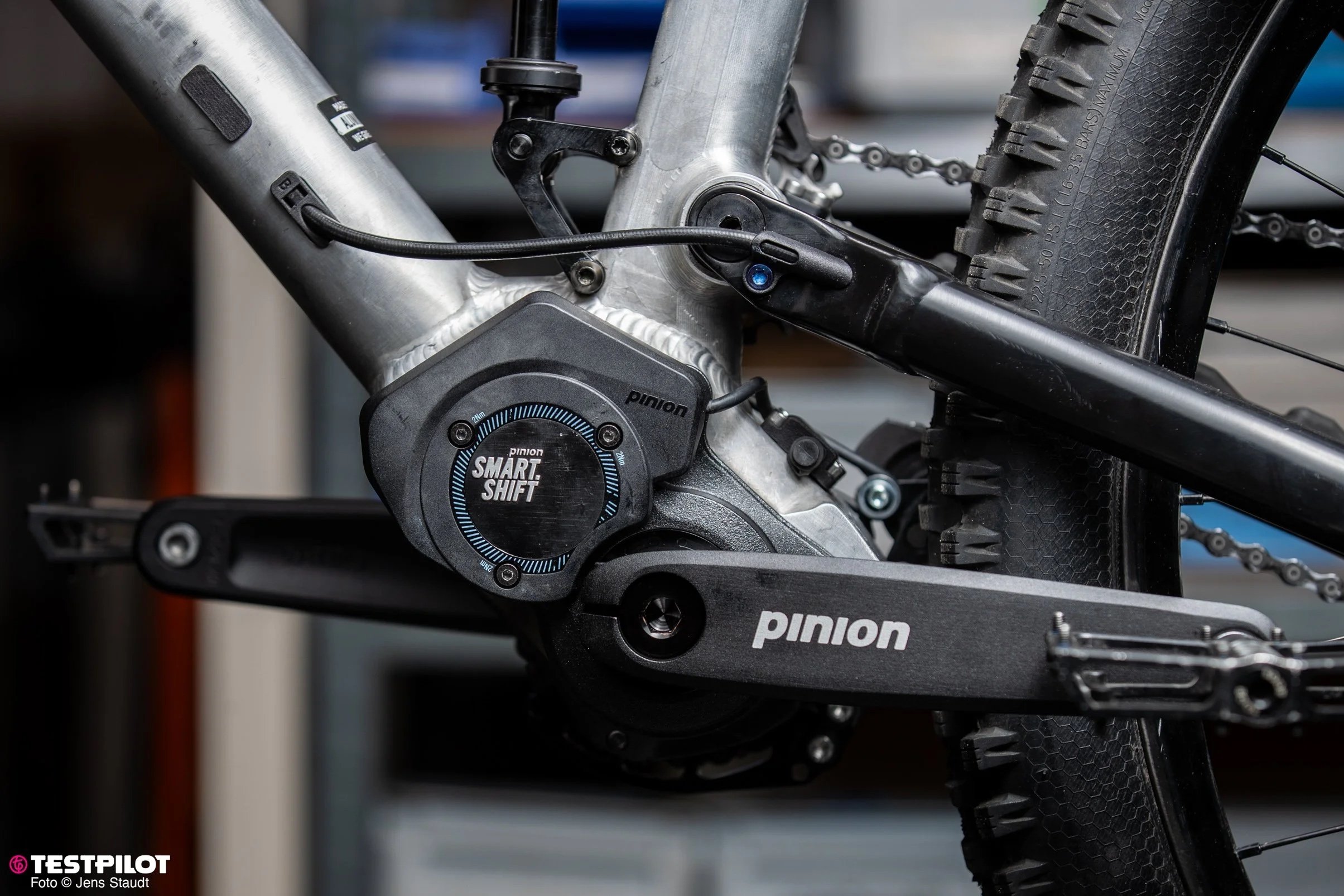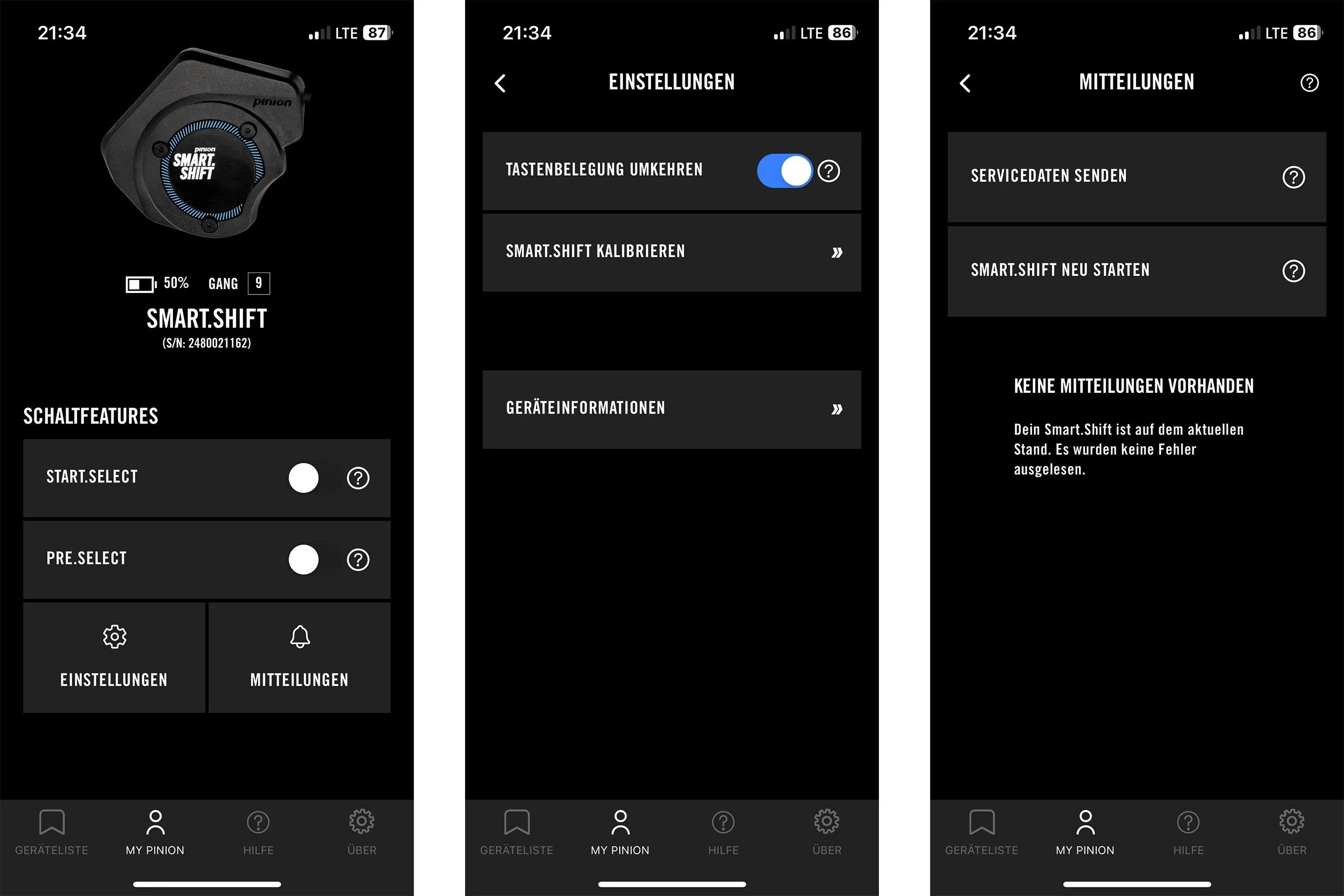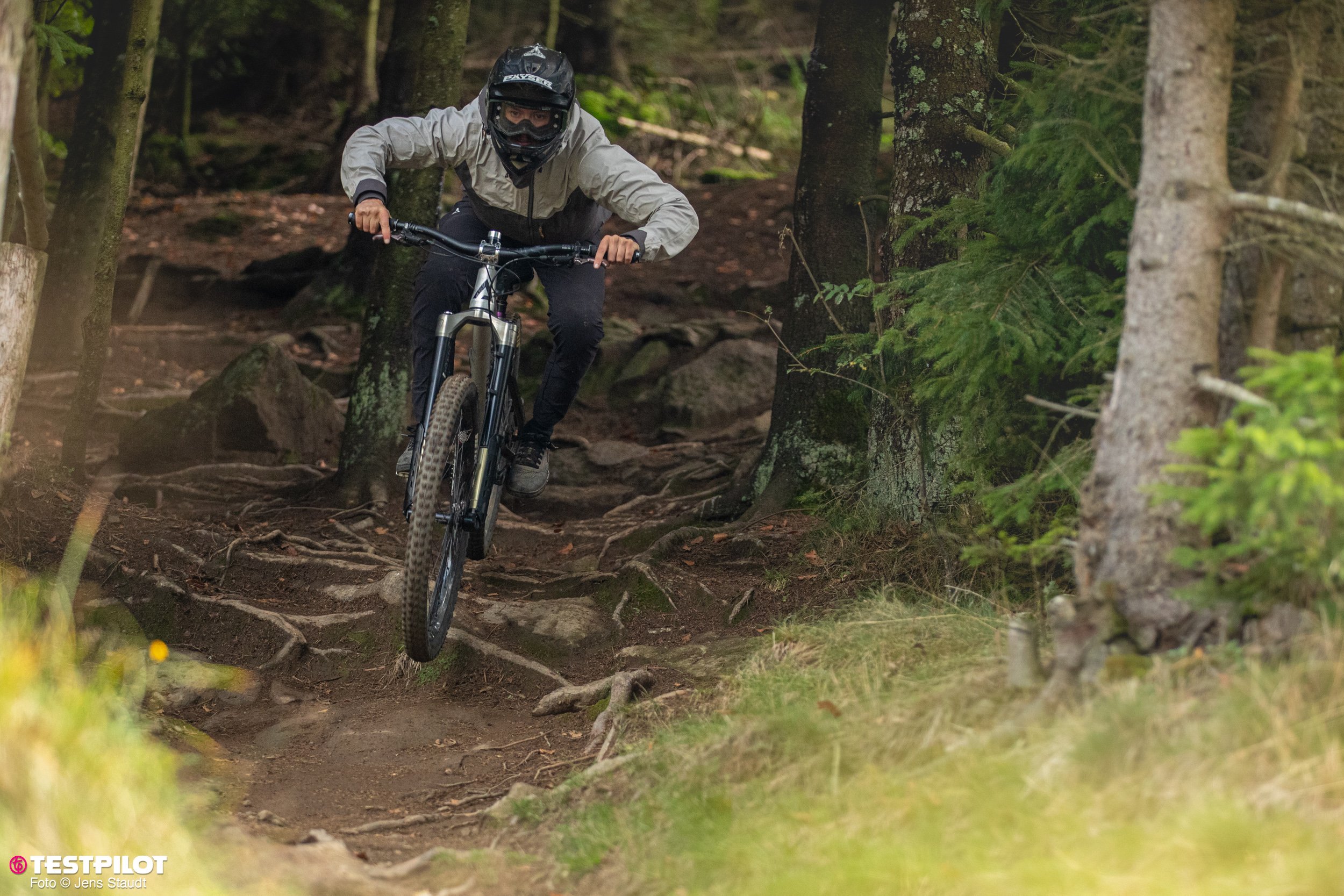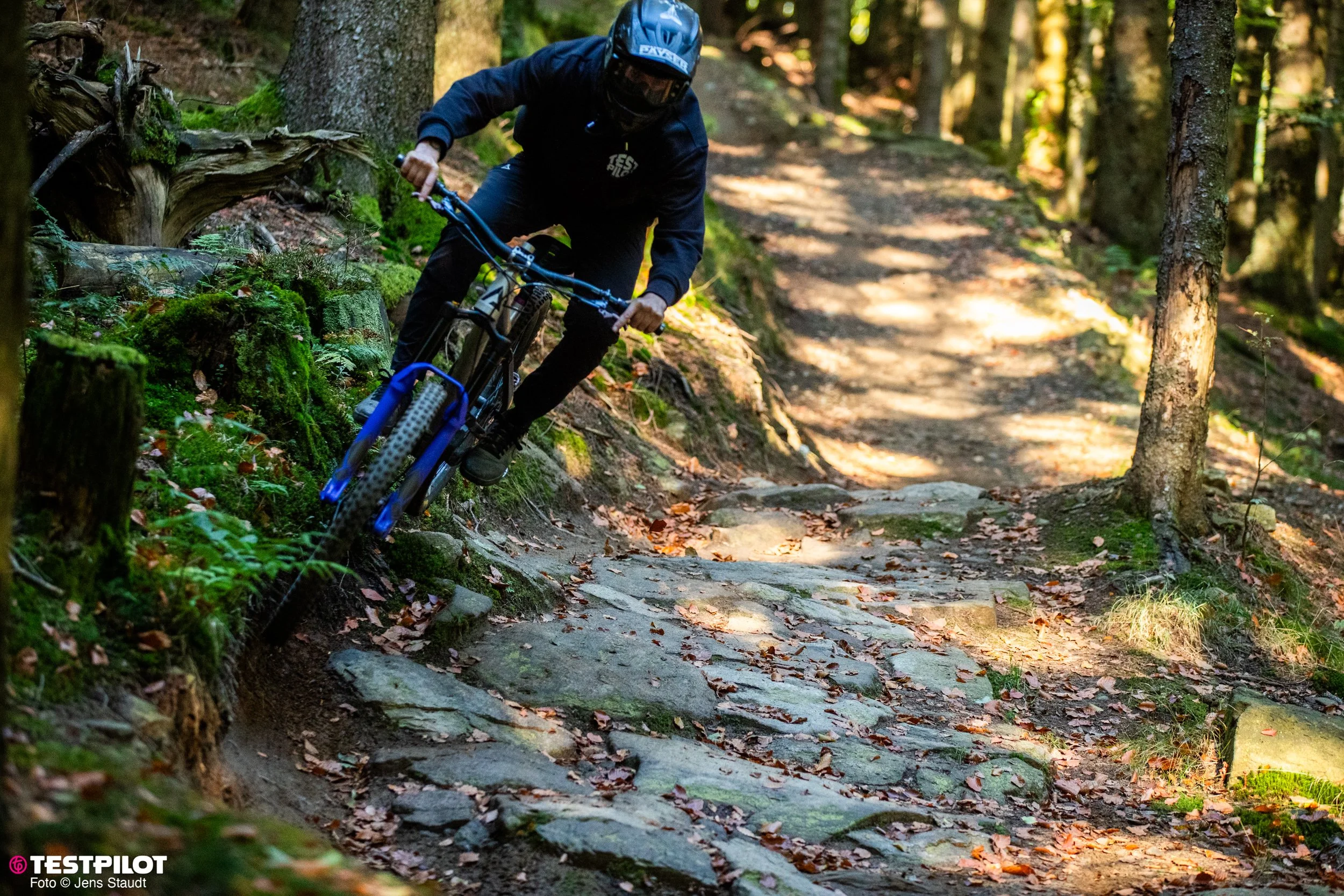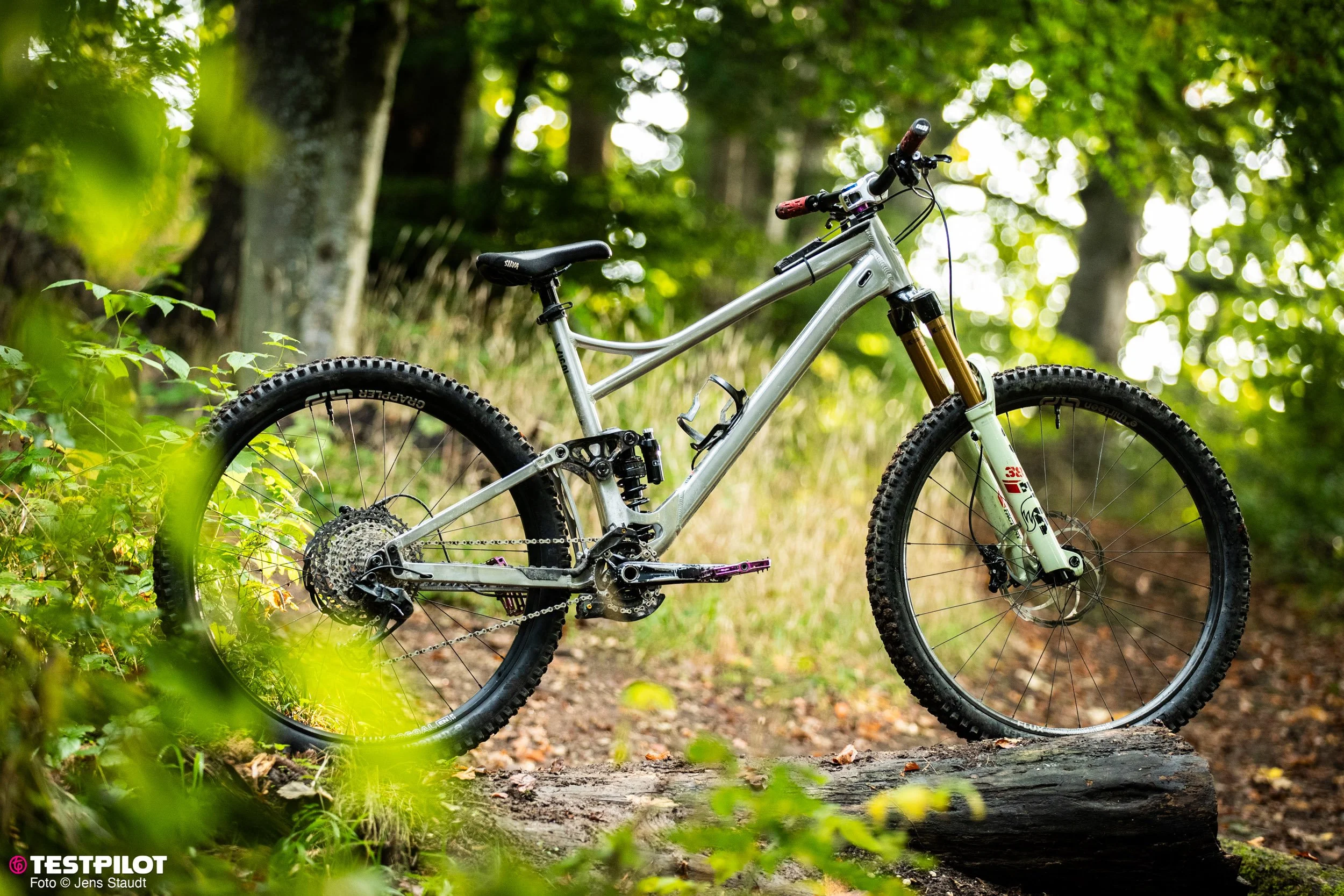Test Kavenz VHP16 G2 – planted. confidence. Gearbox.
Reading time: 12–15 minutes
Tired of bent derailleurs? You are looking for increased suspension performance by reducing your unsprung weight? There are tiny companies out there pushing the boundaries on these things.
The people behind these brands life for innovation and are constantly trying to optimize – the Kavenz VHP16 is one shining example. Already in the seventh evolution you will find many clever solutions on this frame.
What makes it especially exciting is the option to get rid of the derailleur altogether. A Virtual High Pivot rear suspension paired with a Pinion gearbox and chain instead of a belt. Sounds like ultimate traction and the perfect recipe for a hassle-free bike? We put it to the test.
Kavenz
Giacomo has been in the game with his brand 77designz since 2007. In 2019, he unveiled his first VHP prototype at Sea Otter, and that’s when the brand Kavenz was born. He and his team build bikes that might look unassuming at first glance. No carbon. No fancy curves. No extravagant paint job. The goal is to keep things simple in appearance. Straight aluminum tubes define the look of the VHP frames. The Kavenz ideology: straight tubes offer the best stiffness-to-weight ratio and can take the most abuse in the event of a crash. The cool part? Most of the frame’s components are “made in Germany.” Even small custom requests from customers can be accommodated.
When it comes to the kinematics, however, the simplicity ends. The abbreviation VHP stands for “Virtual High Pivot.”
The VHP16 G2 with Pinion Smart.Shift gearbox in classic Kavenz style.
What is a VHP?
Giacomo’s self-declared goal was to build a bike with the best possible performance. From the start, he was convinced it had to be a high-pivot design. In this setup, the rear axle moves backward when the suspension compresses instead of forward – allowing the rear wheel to move out of the way of obstacles. This type of rear suspension typically rewards you with plenty of grip and control.
The downside of high-pivot designs is their very high anti-rise value – which means the rear suspension becomes less active under braking, losing travel and sensitivity. With its VHP concept, Kavenz promises to have solved this issue. At the same time, the bike offers an optimized anti-squat value in the gears you use for climbing, ensuring efficient and pedal-neutral uphill performance. Thanks to the integrated idler pulley, pedal kickback is said to be almost completely eliminated on the downhill.
Sounds great, right? So let’s find out if the plan actually worked. But first, let’s take a look at what makes this bike so special: the drivetrain with the Pinion Smart.Shift gearbox.
Derailleur vs. Pinion Smart.Shift Gearbox
Basically, the VHP comes in two versions. The one with a traditional derailleur could almost be called a classic. The Kavenz team’s constant drive for improvement is reflected in the different generations of the VHP frame – since its debut in 2020, there have already been seven of them.
What’s especially exciting is the option that’s been available since 2023 – the gearbox version. As the “G2” designation suggests, this is already the second evolution of the concept, with the “G” standing for “Gearbox.” The foundation of this bike is the same VHP7 frame used on the conventional model with a derailleur drivetrain. In the bottom bracket area, a dedicated mount for the gearbox is welded on instead of a standard bottom bracket shell.
Instead of a traditional bottom bracket, there’s a welded mount for the Smart.Shift gearbox from Pinion.
Here you can see the Smart.Shift box, which is electronically controlled and handles the gear changes. The charging port is located behind the seat tube.
The drivetrain side with the idler pulley and 77designz’s in-house chain tensioner.
In downhill racing, more and more bikes are appearing with a gearbox. Is this just the $100,000 prize offered by Gates, or does moving away from a derailleur really provide an advantage? Even though pedal-friendly gearbox bikes have been popping up from time to time, most manufacturers in the enduro segment are still holding back.
Kavenz skips the belt and sticks with a traditional chain. Just like the now-standard 12-speed derailleur, the Pinion Smart.Shift box also offers 12 gears. The lowest gear is as easy as a conventional 1×12 setup, roughly equivalent to a 10–60T range – giving a 600% gear span. The entire gearbox sits in the bottom bracket area and is electronically controlled via a trigger on the handlebar. This keeps the drivetrain very tidy: no hanging derailleur, no ever-larger cassette on the freehub. The unsprung mass is reduced, which has a significant positive impact on suspension performance.
No derailleur. No massive cassette. Clean look. Reduced unsprung mass.
What also needs to be considered is the weight difference between the two drivetrain options. In a pure numbers showdown, the derailleur still currently beats the gearbox:
| Component | SRAM X0 AXS | Pinion C1.12 Smart.Shift |
|---|---|---|
| Derailleur | 466 g | – |
| Chain | 256 g | – |
| AXS Pod / Trigger | 50 g | 70 g (TE-1 Trigger) |
| Cranks (170 mm) | 685 g | 486 g (Pinion Forge with Magnet) |
| Chainring 32T | included | ≈ 65 g |
| Gearbox / SmartShift | – | 2,100 g (C1.12 reference) |
| Smart.Shift Box | – | 169 g |
| Smart.Shift Battery | – | 129 g |
| Total Weight | 1,457 g | 3,019 g |
| Difference (Pinion – SRAM) | + 1,562 g → Pinion weight penalty |
What is special about a gearbox?
A gearbox offers several unique features and advantages. Whether it’s the right solution for you, of course, you can decide yourself:
Weight: Some components, like the large cassette and derailleur, are eliminated, but the gearbox currently still adds a bit more weight (see calculation above). However, the centralized weight positioning generally benefits the rider’s downhill performance.
Centralized weight distribution: The bike feels lighter and more stable.
Reduced unsprung mass: The rear suspension responds more easily, as the impact from the ground has less mass to move.
Peace of mind: Derailleurs are a vulnerable point on a bike. Most of us have probably already torn off or bent at least one from hitting a rock. Even the newest and sturdiest options on the market are not invincible. A gearbox keeps the rear clean, gives you more ground clearance, and reduces exposed components.
Shifting: With the Pinion gearbox, you can shift under full load as well as while coasting (without pedaling). This provides advantages both uphill and downhill. More on this in the “on the trail” section.
Quiet bike: With the short and tightly tensioned chain, you ride almost silently over the trail, hearing only your tires.
Efficiency: A derailleur system scores with very high efficiency. Even when the chain runs at an angle toward the cassette, you’ll be slightly more efficient than with a gearbox. In a gearbox, you rotate several internal components with every pedal stroke, and friction simply consumes energy. A chain is still slightly more efficient than a belt. The gearbox is supposed to “run in” and become smoother after about 1,000 km. We cannot comment on this, as our test period from July to October did not reach that distance.
Cost: This is especially interesting with Kavenz. You can order more or less the same bike as a derailleur version or with a gearbox. The price difference is:
VHP16 = from €2,795 without drivetrain
VHP16 G2 = from €3,000 without drivetrain
Price X0 AXS drivetrain = ~ €1,230
Price Pinion Gearbox including cranks (via Kavenz website) = €1,544.94
Technical facts
Complete bike weight: just under 18 kg
Sizes: S, M, L, XL, 2XL, 3XL
Gearbox: Pinion C1.12i Smart.Shift including 26T sprocket set, trigger, battery + charger, lock ring tool, and spacer
Hub: 148 x 12 mm with HG freehub
Chain: 11-speed chain
Travel: Adjustable, depending on shock mount. Detailed information in the next section “Converting the VHP V7.”
Shock mount: Interchangeable to adjust the bike’s character and travel. Options available: VHP12 29, VHP14 and 16 MX, VHP14 and 16 29, and VHP18 MX. For VHP18 29, there is a separate dropout in the next section. 29 stands for the full 29er version and MX for the mixed mullet bike.
Chainstay length: With interchangeable dropouts, there are different options depending on preference and riding style: 0, +10, and +20. Kavenz provides recommendations for which dropout fits which frame size:
0 = Size S & M
+10 mm = Size L & XL
+20 mm = Size 2XL & 3XL
18-29 +20 mm = for riding the VHP18 as a full 29″
Idler pulley: 16 teeth, redesigned for long-lasting, smooth performance
Derailleur hanger: UDH
Frame bearings: Black Oxide Bearings from Enduro Bearings
Price: The frame is available from €3,000. The Pinion gearbox can be added directly to the cart during checkout on the Kavenz website for €1,444.99. The matching Pinion Forge crank can be added for an additional €99.95.
Included with the frame: 16T idler pulley, chain tensioner, 77designz chain guide, cable routing parts, thru-axle, 77designz seat clamp, anti-rattle tube for internally routed cables, chainstay protector
Warranty: 5 years, frame only (excluding bearings)
Availability: Preorders for the VHP G2 are currently closed and frames are in production. A few additional frames will be built.
NOTE: Please contact Kavenz first to check if your desired size is still available.
Changing the VHP V7
Kavenz uses a kind of modular system. For you as the end customer, this means you’re not locked into a single bike. What does that mean? The frames are basically identical – regardless of the model. By swapping the shock mount and the shock itself, you can change the travel of your Kavenz and prepare it for either 29″ wheels or mixed wheels (29″ front / 27.5″ rear). Additionally, as described in the previous section, you can swap the dropouts.
The cost for a shock mount is €59.95 and for a new dropout €194.99. Of course, you’ll also need a different shock, and the fork travel should be adjusted, but this is still cheaper than buying an entirely new frame. The shock mounting hardware is always the same: Trunnion at the top and 22x8 mm at the bottom.
Here is an overview of the possible variants:
| Model | Shock size | Rear travel | Recommended fork travel |
|---|---|---|---|
| VHP 12 29 | Trunnion 185 × 47,5 mm | 121 mm | 130-140 mm |
| VHP 14 MX | Trunnion 205 × 57,5 mm | 144 mm | 150-160 mm |
| VHP 14 29 | Trunnion 205 × 57,5 mm | 144 mm | 150-160 mm |
| VHP 16 29 | Trunnion 205 × 65 mm | 160 mm | 160-180 mm |
| VHP 16 MX | Trunnion 205 × 65 mm | 160 mm | 160-180 mm |
| VHP 18 MX | Trunnion 225 × 75 mm | 183 mm | 180-200 mm |
| VHP 18 29 | Trunnion 225 × 75 mm | 184 mm | 180-200 mm |
On the VHP frame, the lower shock mount can be swapped, allowing you to change the travel or the rear wheel size. Note: pay attention to the shock’s installation dimensions.
The dropouts are bolted on and can be adjusted from 0 to +20 mm.
Geometry
| Size | S | M | L | XL | XXL | XXXL |
|---|---|---|---|---|---|---|
| Reach | 440 | 460 | 480 | 500 | 520 | 540 |
| TT Length | 578 | 598 | 618 | 638 | 658 | 678 |
| Stack | 639 | 639 | 639 | 652 | 652 | 652 |
| Seattube Effective | 77,5° | 77,5° | 77,5° | 77,5° | 77,5° | 77,5° |
| Saddle Height Effective ST | 750 | 750 | 750 | 750 | 750 | 750 |
| Actual ST Angle | 75,5° | 75,5° | 75,5° | 75,5° | 75,5° | 75,5° |
| Seattube Offset at BB | 21 | 21 | 21 | 21 | 21 | 21 |
| Seat Tube Length | 400 | 420 | 450 | 450 | 480 | 480 |
| Head Tube Length | 110 | 110 | 110 | 125 | 125 | 125 |
| Head Tube Angle | 64° | 64° | 64° | 64° | 64° | 64° |
| Based on ACT | 581 | 581 | 581 | 581 | 581 | 581 |
| Fork Offset | 44 | 44 | 44 | 44 | 44 | 44 |
| Chain Stay Length* | 419 | 419 | 419 | 419 | 419 | 419 |
| Wheelbase | 1203 | 1223 | 1243 | 1263 | 1283 | 1303 |
| Bottom Bracket Drop | 34 | 34 | 34 | 34 | 34 | 34 |
| Estimated BB Height 29" | 343 | 343 | 343 | 343 | 343 | 343 |
| Stand Over Height | 783 | 783 | 783 | 783 | 783 | 783 |
The marriage: Pinion + Kavenz
We’ve never installed a gearbox ourselves. So we took the opportunity to take a closer look and had the specialists at Pinion show us how it’s done. Here are a few impressions of the marriage:






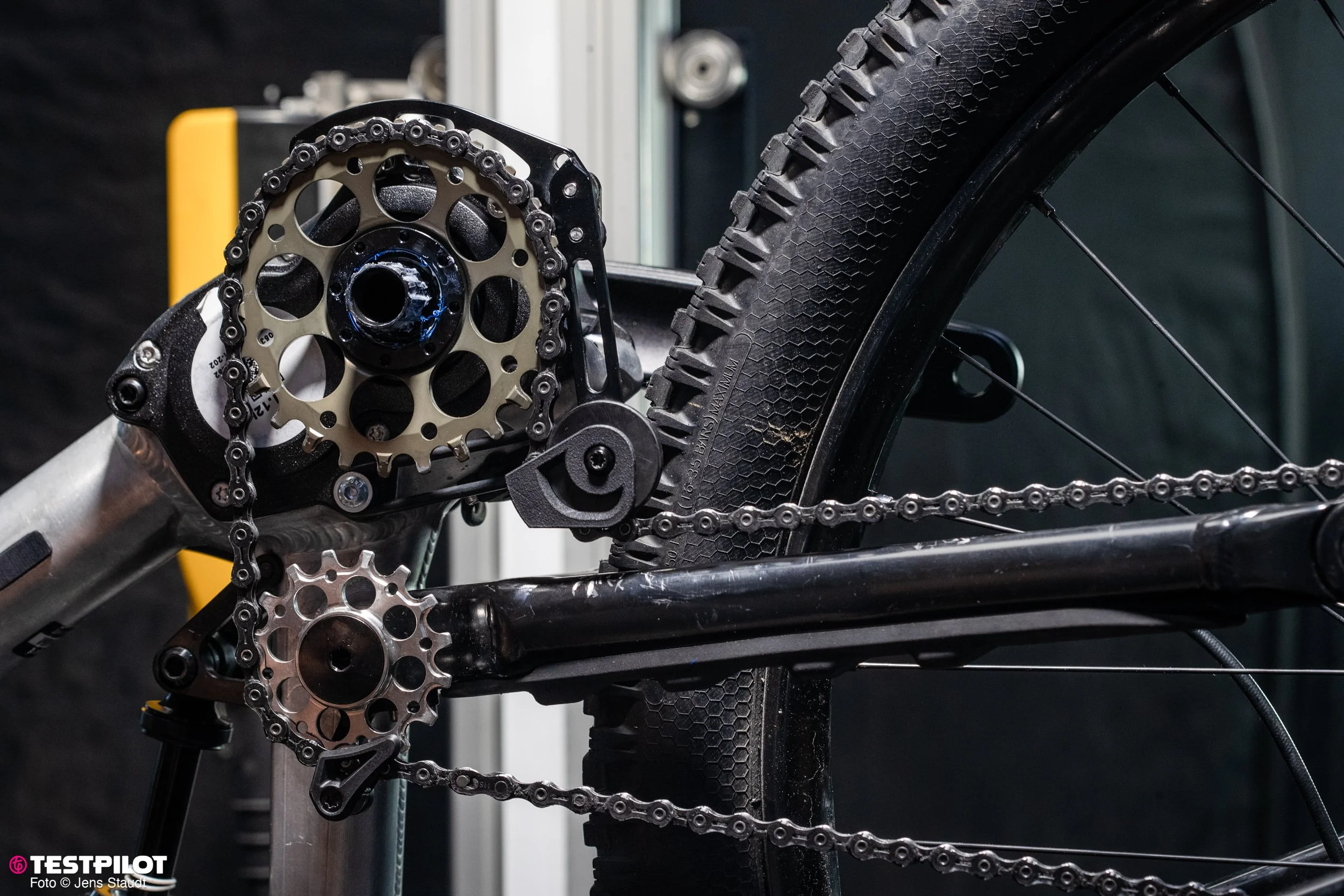
Pinion Smart.Shift App
With the Smart.Shift app, you can check the battery level, reverse the shifter button assignment, calibrate or restart the system, and make minor customizations.
Start.Select: “Safe and energy-saving starts are especially important on e-bikes. Start.Select can be activated for this purpose. Set the desired starting gear, which will automatically engage when you stop.”
Pre.Select: “Here you can choose your ideal cadence. While coasting, Pre.Select automatically shifts to the gear matching your speed. For example, it ensures you’re always in the right gear on flowing trail sections, even without pedaling or manual shifting. When stopping, Pre.Select takes the preset starting gear into account.”
During our test period from July to October, Smart.Shift didn’t need charging and used only 50% of the battery.
The user interface and menu options of the Smart.Shift app.
Kavenz VHP G2 on the trail
The G2 was tested in the VHP16MX configuration with mullet wheels and a size L. The Intend suspension was also swapped with other brands as part of our ongoing suspension test. The Kavenz was ridden on the German hillsides/mountains, on steeper enduro tracks, alpine and technical trails, as well as in bike parks.
Uphill
he gearbox is installed. Out of the Pinion workshop. A quick lap around the parking lot. The first gear shifts feel unusual. Press the shift lever. A short whir. Click, the gear is engaged. Where a conventional derailleur gives feedback from the chain moving up or down, with Pinion there’s a brief pause until the next gear is fully engaged. An audible confirmation can be clearly heard with each shift. When coasting relaxed in the saddle around the parking lot, the shift happens immediately. Under more pedal pressure, the system delays the shift slightly to create a smooth feel similar to a derailleur.
When shifting from gear four to five, you hear a longer shifting noise from the gearbox. This range is used more often during uphill riding. According to Pinion, the gear change should always be equally fast – here it feels slightly longer. Is that just an auditory illusion? If you like to double-shift, you have to press the lever twice and cannot hold the trigger down.
A rider who plans his lines accordingly will benefit from this system and will be faster to adapt his shifting behavior.
The biggest benefit is that you can shift even while coasting without pedaling. Once you get used to this, it brings a lot of freedom to your riding, allowing you to fully focus on the next section – without frantically trying to find the right gear the moment you already need it.
This is not just an advantage on climbs. Riders who can read the terrain and gauge their bike will always pedal in the correct gear. If an unexpected obstacle appears, you can still shift under full load with the gearbox. However, if you want to shift two or three gears at once, the resulting slack in the gear change can pull you unexpected toward the handlebars.
During uphill riding, you can feel the friction inside the gearbox – many components and gears are being moved with each pedal stroke. According to Pinion, the system should “run in” after 1,000 km, becoming smoother. I felt the difference in drag clearly when switching back to a traditional derailleur bike.
Many components and gears inside the gearbox have to be moved – you can feel that.
The rear suspension of the Kavenz VHP G2 delivers on its promise – uphill it shines with its pedaling neutrality and comfortable riding position. With enough power in your legs, you can pedal along nicely on the trail. Otherwise, you can just take it a bit easier. However, once you reach the trailhead, this mindset changes very quickly.
Downhill
A high-pivot bike with a heavy gearbox? That must be sluggish and just stick to the ground! The little devil of prejudice on my shoulder tries to influence me before I even point the bike downhill.
The first meters are surprising. The rear suspension delivers sensitivity and grip as expected – but it exceeds expectations. Rocks? Roots? The VHP G2 doesn’t care at all. Unstoppable and with stoic force, the bike powers through everything in its path. With the same freedom, I stand on the flat pedals with my shoes, no matter how wild it gets.
Off the brakes. Let it loose. Roots? Rocks? Nothing matters to me.
Gradually, I open up the rebound. And once again, the Kavenz surprises me. Does the G2 ever get nervous at all? The bike allows a really fast rebound – without losing contact between shoes and pedals. This bike simply can’t be unsettled. On drops and hard landings, the rear suspension impresses with a progressive curve and inspires confidence. Full commitment, no compromises!
The Kavenz VHP G2 manages the balance between a bike that flattens everything on the trail while still generating enough pop to get airborne.
The rear suspension not only generates grip – when the rider gives input, it surprises with plenty of pop and helps you clear jumps and gaps.
The frame offers a comfortable balance of stiffness and flex – providing confidence while allowing quick changes of direction without tiring. The bike seems to generate endless grip and requires a lot of input from the rider to let the rear wheel break loose. At the same time, it has enough stability in fast bike park sections to keep picking up speed.
CoPiloten Eva and Tim: When you ride a bike, you often have to get used to the geometry or the components first. With the Kavenz, it only took a few meters for everything to just feel right: get on it, start riding, have fun. No matter the trail. Whether it’s flowing or rough. You always felt secure. Everything just clicked. An impressive bike!
Things we needed to take care of during testing
Even a gearbox bike isn’t completely maintenance-free. During the test period, a few things came up. Here’s a chronological overview:
Chain rattling: A chain guard is used on the top of the chainstay. At the bottom there is no guide, so you can hear the chain rattling there. With a bit of Slapper Tape, this problem can be easily fixed, resulting in a bike so quiet you’d think it was running without a chain.
Punctured tire: The rear tire with Enduro casing gave out after a blunt rock impact. Considering the speeds the G2 allows, it might be worth installing an insert or a downhill tire. Praise goes to the We Are One carbon rim – it remained visibly unfazed by the impact.
Broken chain: An Extralight chain was installed – possibly not the best choice for a system that can shift under full load. In alpine terrain, the chain broke when starting on a slightly steep uphill section.
Broken O-ring on the chain tensioner: In the bike park, the O-ring holding the chain tensioner broke. Necessity is the mother of invention – using three cut pieces of inner tube, the chain could be kept sufficiently tensioned. The Kavenz team can provide the correct O-ring as a spare part.
Creaking noises: After about 2.5 months, creaking occurred while pedaling. I first disassembled and cleaned the rear suspension – that didn’t help. Could it be the gearbox? After a short call with Pinion, they advised me to check the mounting bolts of the gearbox on the frame. For this, the Smart.Shift Box must be unscrewed. Set torque to 10 Nm and retighten everything once. Voilà – the creaking is gone. As with any bike, bolts settle over time and should be checked regularly.
The Extralight chain broke when starting on a steep uphill.
The O-ring on the chain tensioner failed. We managed to improvise using three pieces of inner tube.
The gearbox mounting bolts should be checked and retightened after the first rides. They had loosened slightly, causing the gearbox to creak – once tightened, everything was fine again.
Who would enjoy a Kavenz VHP16 G2 the most?
If you want to go full throttle downhill, this bike will make your day on every trail and help you keep pushing harder – no matter how wild it gets. If you’re looking for a bike that gives you a lot of feedback from the ground, especially on flat trails without major obstacles, it might not be the perfect companion for you. In the bike park, it pushes you to ride every descent faster.
In alpine terrain, it makes riders without a Pinion gearbox look slow. Even before a technical uphill, you can coast in the perfect gear. Everyone else starts frantically shifting and pedaling, or ends up pedal-striking with their cranks. Forward-thinking riders who can read the trail will love this function of the Pinion Smart.Shift.
Uphill, you should expect it to cost you a couple more watts and that you might not be the first in the group – depending on your fitness level, of course. But who really enjoys climbing? It’s always about the descent, isn’t it?
Conclusion
The Kavenz is more than just a bike. It’s a platform. It’s adjustable in travel, chainstay length, and rear wheel size. With the gearbox option, it opens up an additional market.
A bike with a gearbox isn’t aimed at setting uphill best times – and it doesn’t have to be. In technical terrain, you have the edge because you can shift while coasting – uphill and downhill alike. Even if you probably shift far less on the descent, the performance of the free-moving suspension will impress you. The extremely sensitive yet active rear suspension rewards you with plenty of control and composure. At the same time, it won’t let you down when you want to gap over roots or rocks to go even faster.
Carefree, without worrying about smashing a derailleur on a rock, you can hammer through the roughest rock gardens. This is exactly where the Kavenz VHP16 G2 with gearbox excels. Absolute downhill performance. No rattling. No transfer of impacts. Pure control. The rear suspension allows for a fast rebound setting, so you’re always able to keep the bike agile.
You want more reviews?
Autor – Yannick Noll
Height: 178 cm
Weight: 75 kg
Riding style: As a former racer, it should be fast and flowing. Bigger jumps and steep ramps are also a must. The bike is tuned a bit firmer and quicker so that it responds promptly to rider input.
Motivation: It should be fun. A bike shouldn’t be boring, just flattening everything. The character can be a bit livelier – both in its setup and in the riding style. The product should be durable and function reliably even on longer bike trips.


